1. Can you outline why your team embarked on this project and the problem that needed to be solved?
Since its inception in 1908 bp has always been about transitions; from coal to oil, from oil to gas, and then from onshore to deep water. Most recently bp launched a transformation to reimagining energy for people and our planet. bp wants to help the world reach net zero and improve people’s live. They are doing this by transforming and delivering the reliable, affordable and lower-carbon energy the world needs. Any bp employee will tell you the company is not just reimagining energy; they are transforming how their organization works to deliver on the promise. And that includes how they work with JLL as a strategic business partner to reimagine facilities and real estate operations globally.
The transformation of bp’s facilities and real estate contracts began in the spring of 2020 when bp made the strategic decision to create a Vested outsourcing agreement and ultimately sought to the best supplier from the three down-selected candidates. JLL was ultimately selected as the partner of choice the first week of June 2020 with the goal to work with bp to reimagine workplace solutions across the globe.
2. How were things done originally and what was the inspiration to innovate the process?
bp has a long history of outsourcing facilities and real estate management services. bp’s total facilities management portfolio includes over 132 locations in 20 countries – the majority of which were outsourced to four primary service providers. Like most organizations, bp’s procurement organization used a competitive bid process to test the market to ensure it was getting the best deal from suppliers. In the case of this project, a traditional bid was issued to seven supplier candidates who could potentially manage over 6.8 million square feet of bp’s corporate real estate. The only “new” aspect was structuring the bid where the smaller parts could potentially be bundled with a global supplier.
Wendy Cuthbert joined bp as the Global Head of Workplace Solutions in late 2019, when the project was well under way. Wendy thought to herself. “We have some really good suppliers – but we are not challenging ourselves to think outside of the box.” Wendy came to bp as an outsider; she was experienced with various sourcing business models companies could use for outsourcing. Cuthbert explained: “What we were doing was issuing an RFP to the same suppliers using the same approach we had in the past. So, nothing was really changing besides the fact that we had structured to bid where the smaller parts could potentially be bundled with a global supplier. We hadn't looked at different sourcing models such as Vested. I tapped into my network and one of my old commercial managers suggested I contact the University of Tennessee to learn about the Vested methodology.” Ultimately bp hosted two workshops for key stakeholders to learn about Vested getting bp’ers to challenge the status quo.
After the workshops bp changed their approach from picking a supplier to picking a strategic partner who would help them co-create a Vested outsourcing relationship. Below is the shared vision and six Desired Outcomes bp and JLL established for their partnership (referred to as wevo for Workplace Evolution).

3. What KPIs did you use to measure success for this project? (For example: performance, customer satisfaction, revenue, sales or relevant financial gains?)
Transition Success
• 98% Transition Success shifting from 4 supplier to JLL –something remarkable considering the transition was in the height of Covid and virtually all meetings were done virtually
• 93% of talent transitioned to JLL with retention rates exceeding 90% - well above industry norms
• 40% of the team is diverse – well above industry norms
Processes Transformation
• Successful ramp up of new processes on time and within budget, including new global financial reporting capabilities and processes that now allow bp to track financials well beyond simple budgets and make business decisions that impact total cost-of-ownership decisions. The result has led to millions of dollars in smart cost avoidance decisions within the first year
• Deliver over 100 projects in the first year alone with no impact on business-as-usual.
• Over 1,000 nominations for both individual and team acknowledgments
Achieving Critical Goals
• Breaking safety records (US achieving 0 (Zero) recordable incidents)
The actual results are shown in the graphic below:
4. How you plan to ensure that the new model remains relevant and adapts to the future needs of the market?
A key part of the Vested process is having robust governance mechanisms and a contractual commitment for continuity of resources process and ‘onboarding’ training ramp up new team members on the Vested Five Rules. The onboarding program is designed so the Univ of Tenn online course providing the fundamental basics of “why and what of Vested” and the live “induction” training helps team members understand how the parties apply the Vested Five Rules for their relationship. The training is designed to be completed within 90 days of a new team member joining the team. Induction training is designed by team members – for team members so team members “could pick up the key concepts of Vested and how the Five Rules worked in practice in the field.” In addition, there are two “executive” level sessions where higher level individuals who are not dedicated to the partnership receive a condensed version about Vested and how bp/JLL apply the rules in their contract and working relationship.
A Vested agreement creates a true win-win agreement threading all of the way down into the contract terms. The Vested methodology safeguards the future benefits by ensuring contracting partners are truly wedded in each other’s success – a win for the buyer is a win for the supplier, and vice versa. However, it is important to note that “business happens”. For this reason, the Vested methodology formally embeds a robust governance structure spanning four elements (Relationship Management, Transformation Management, Exit Management and Compliance against special concerns and external regulations). Parties use their governance – in conjunction with formal Guiding Principles – to make decisions that remain win-win (or lose-lose). This alignment means that there is no perverse incentive for either party to engage in what Nobel Laureate Oliver Hart calls “contractual shading”.
5. What advice do you have for those who may want to implement this innovative approach in their own organizations?
We’d like to answer this from two different angles.
First, from a broader perspective on what advice do we have for companies considering Vested. We suggest having people read the various case studies and books on Vested for inspiration! Of course, the bp-JLL case study is our latest case study, but we also recommend Vested: How P&G, McDonald’s and Microsoft are Redefining Winning in Business Relationships because it shares some of our favorite examples of how real-world companies are applying Vested in different situations.
Second, from the perspective of the bp-JLL team members that lead work to transform how they thought about their strategic outsourcing relationships and in particular making the switch to Vested. The team suggests twelve tips for anyone considering going down the Vested path.

We have put a lot of thought into the tips and are happy to go into more detail and share the lessons with others (e.g., on a webinar, podcast, SIG session).
6. What factors do you think are the most important to consider when innovating in this category?
Anytime a company is looking to change, the need to change. The problem is the only one that likes change is wet baby. We recommend team think about five factors of change readiness when it comes to making the shift to a Vested strategic relationship.
|
Stakeholder Analysis
|
Are key executives and Stakeholders on board?
|
|
Vested Knowledge Base
|
Do both organizations understand the fundamentals of Vested? Are there at least 2 people from each partner who are prepared to learn (and lead) their organizations through the Vested methodology?
|
|
Champions
|
Is there an overall Champion from both companies driving the progress?
|
|
Organizational Alignment
|
Are all impacted functions and levels of authority on board and supportive of shifting the focus? How can I get team members onboard and engaged to contribute to the change effort?
|
|
Guardrails (Dynamic Mandate)
|
Making the shift to a transparent win-win relationships means making the shift to a formal relational contract. It is important for the buyer and supplier to articulate what their walk-away issues are as they begin to go down a path of being highly strategic and highly transparent.
|









